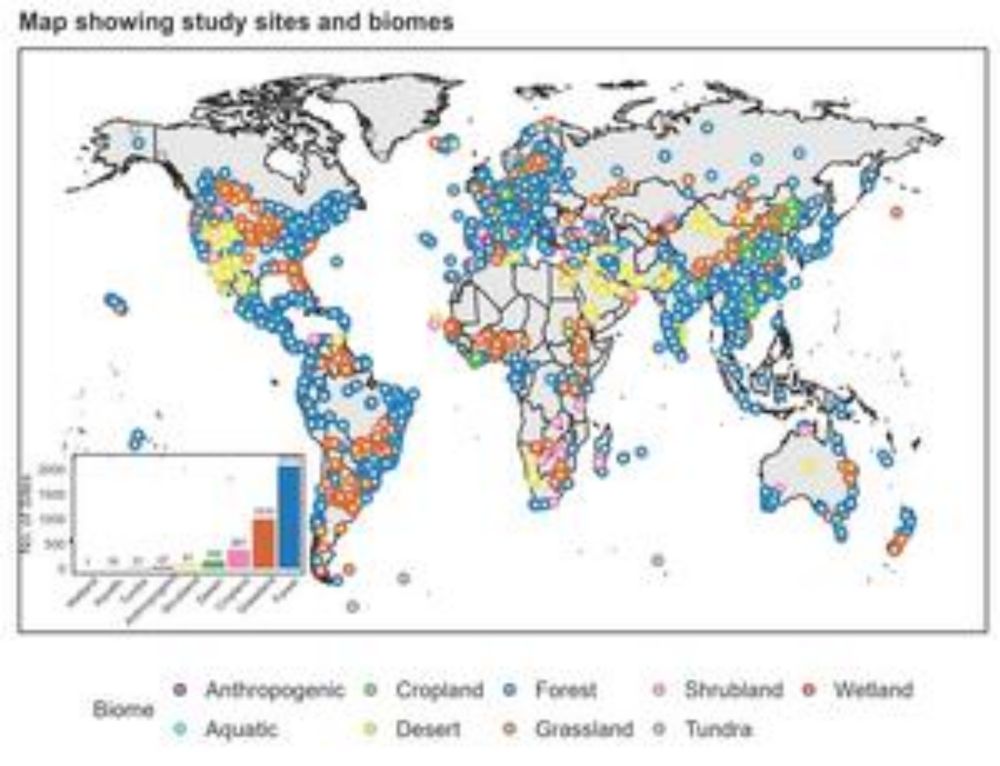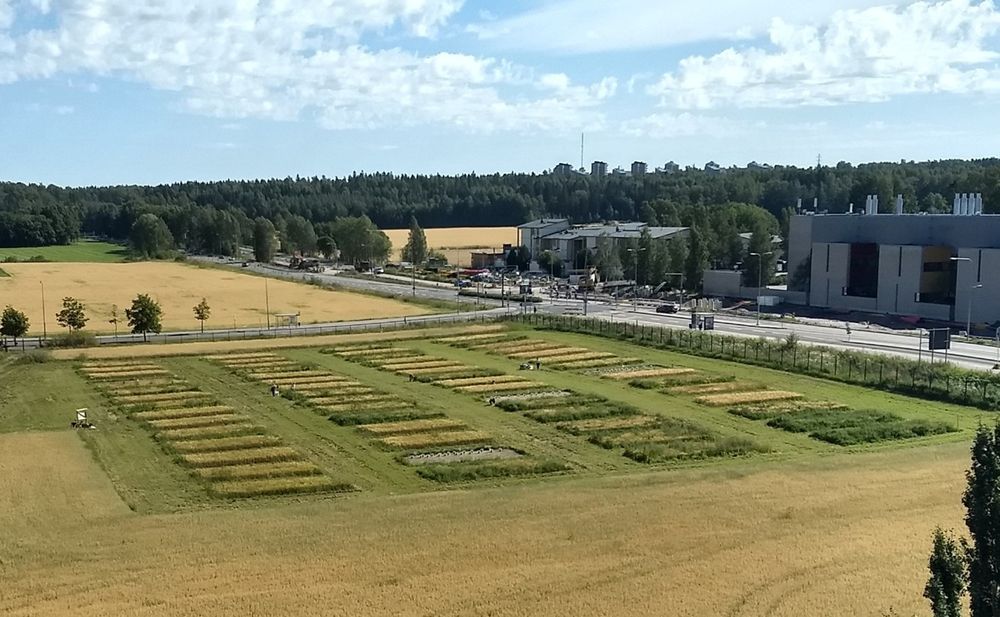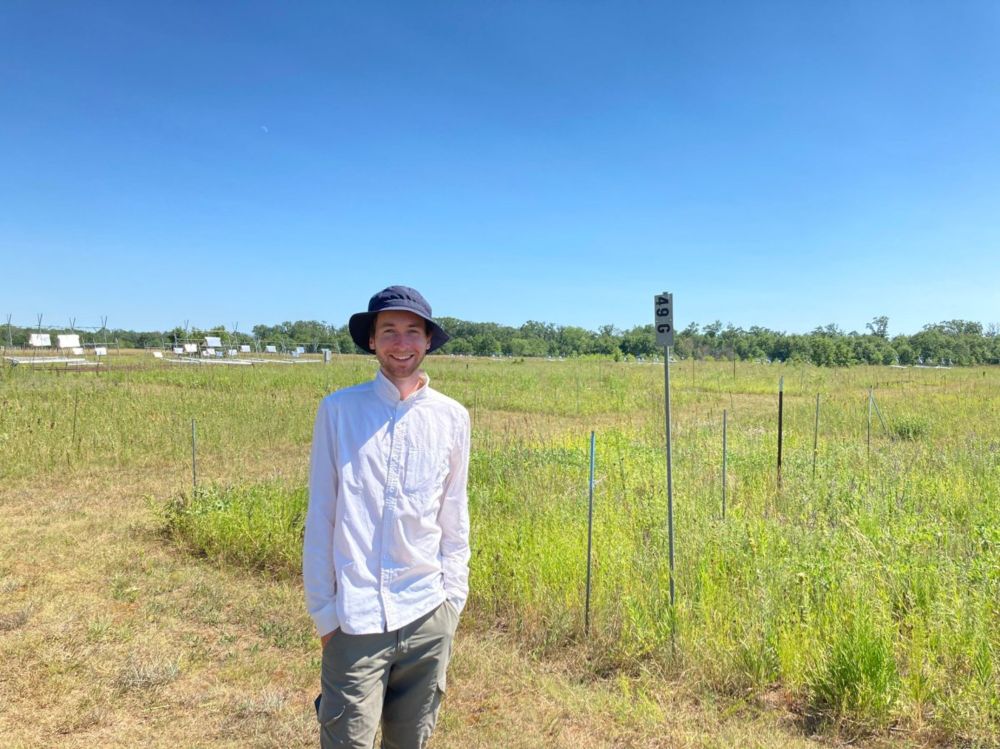📣📣📣 This 👇
20.11.2025 08:58 — 👍 1 🔁 1 💬 0 📌 0
The new Wiley journal review system is an absolute nightmare. Editorial assistants have been replaced by a clunky, AI-enabled website that makes it harder to find and invite reviewers. Associate editor workloads have increased. I'm not convinced the invitations to reviewers are even going through.
06.10.2025 15:21 — 👍 158 🔁 65 💬 11 📌 17

Seriously @globalchangebio.bsky.social & @wiley.com ?! 😡🧪🌍
29.09.2025 15:36 — 👍 7 🔁 2 💬 0 📌 0
- cran.r-project.org/web/packages...
- rdrr.io/github/Benja...?
03.09.2025 19:01 — 👍 0 🔁 0 💬 1 📌 0
The bigger, the better! But honestly, I just have no idea of American units 😅 You can download the poster here: koiosjerome.direct.quickconnect.to:5001/sharing/CxrG... and I am more than happy to chat about it anytime 😃😃😃
14.08.2025 14:31 — 👍 1 🔁 0 💬 0 📌 0

Are you at @ESA2025 today? Come see my poster (263) about small consumer impacts on plant litter impacts on decomposition!
14.08.2025 13:45 — 👍 15 🔁 2 💬 1 📌 0

How climate shapes soil fungal traits
Many soil microbes play a vital role in ecosystems, as they help plants access nutrients and water and assist in stress tolerance such as during drought and to defend against pathogens. One such group...
Our new global study led by @smriti-pehim-limbu.bsky.social is now out in @pnas.org. TLDR: Certain spore traits were linked to climate AND species range sizes! YES we can use traits to gain insight into env adaptations for microbes.
#mycorrhizas #spores #NSFfunded
www.eurekalert.org/news-release...
29.07.2025 18:43 — 👍 41 🔁 17 💬 1 📌 1
at FEMS Microbiology Ecology here: doi.org/10.1093/fems...
30.06.2025 19:00 — 👍 1 🔁 0 💬 0 📌 0
The study focuses on soil microbial communities. Benefits to the current crop are not presented in this study (see other studies from the experiment for this). Soils from plots with legume cover crops in the previous year increased AMF colonization in flax, suggesting benefits to following crops.
30.06.2025 18:52 — 👍 0 🔁 0 💬 0 📌 0
With Karoliina Huusko, @omsietio.bsky.social, Bernhard Schmid, Paula Thitz, Stephanie Gerin, @annaliisalaine.bsky.social, Annalea Lohila and @jheinons.bsky.social 6/6
30.06.2025 16:01 — 👍 2 🔁 0 💬 1 📌 0
Overall, diverse cover crops, particularly mixtures including legumes, sustained diverse and beneficial
fungal communities over winter, already after one
year of expeirment. Agricultural diversification using CCs may have positive impacts on the microbial communities. 5/6
30.06.2025 16:01 — 👍 1 🔁 0 💬 1 📌 0
Some highlights of many results
-vegetation and cover crop richness increased microbial biomass and microbial growth efficiency
-Cover crop richness increased AM fungal diversity while legumes suppressed fungal pathogens
-Legumes boosted next years crops association with beneficial AM fungi
4/6
30.06.2025 16:01 — 👍 1 🔁 0 💬 1 📌 0
For her PhD project, Rashmi characterized #TWINWINS bulk soil microbial communities across seasons, and used additional experiments to assess decomposition and legacy effects on AM colonization in a consecutive crop. 3/5
30.06.2025 16:01 — 👍 1 🔁 0 💬 1 📌 0

TWINWIN experiment design: (a) Three control (bare fallow, barley + herbivide, barley monoculture) and four undersowing treatments (diversity levels 1, 2, 4, and 8). (b) The eight undersown species /Trifolium hybridum, T. repens, T. pratense, Medicago sativa, Lolium multiflorum, Phleum pratense, Festuca arundinacea and Cichorium intybus) vary in rooting depth and N-fixation
capacity, leading to four different ‘functional types’. (c) The undersown communities vary in richness and functional diversity (number of functional types of undersowns in a plot). (d) The 60 plots are arranged in four blocks.
Figure 2 from Cappelli, Seraina Lisa; Domeignoz Horta, Luiz Alberto; Gerin, Stephanie; Heinonsalo, Jussi; Lohila, Annalea; Raveala, Krista et al. (2024): Potential of undersown species identity versus diversity to manage disease in crops. In Funct Ecol 38 (7), pp. 1497–1509. DOI: 10.1111/1365-2435.14592.
#TWINWIN experiment is an agricultural biodiversity experiment, where the agricultural crop is undersown with cover crop species mixtures of varying species richness and functional composition to test if results from ecological biodiversity experiments can be applied to agricultural practices. 2/6
30.06.2025 16:01 — 👍 3 🔁 0 💬 1 📌 0

Aerial view on the 60 plots of the TWINWIN experiment surrounded by grass and agricultural fields. The plots vary in color that represent the different undersown treatments. In the background is a road, buildings and forests. The sky is blue with some white clouds.
🚨📃🧪 New paper out: "Impacts of diverse undersown cover crops on seasonal soil microbial properties". Rashmi Shrestha used the #TWINWIN experiment to show that undersowing crops with diverse plant mixtures, particularly including legumes has beneficial effects on soil microbial life and function 1/6
30.06.2025 16:01 — 👍 23 🔁 5 💬 3 📌 1
Oh no! You will spend the rest of your life on this mountain 🫣
29.05.2025 19:58 — 👍 1 🔁 0 💬 0 📌 0
I hope thyme is not on your species list 😅😜
27.05.2025 20:53 — 👍 0 🔁 0 💬 1 📌 0

The Swiss Federal Institute for Forest, Snow and Landscape Research WSL is part of the ETH Domain. Approximately 600 people work on the sustainable use and protection of the environment and on the handling of natural hazards.
Due to retirement, WSL invites for applications for the position as
Head of Research Unit Forest and Soil Ecology 90-100% (f/m/d)
You will lead and inspire an internationally recognized Research Unit comprising seven well-established, strong Research Groups and approximately 100 collaborators from around 20 countries. As a distinguished ecologist, you will play an important role in national and international projects focusing on forest or soil science. In the unit, you will integrate diverse research fields, while facilitating and promoting the scientific and strategic development of the research groups. By your extensive experience you will align the unit with WSL’s vision of fostering research for people and the environment in a changing world. You will engage with key forest authorities and expert organizations, ensuring impactful collaborations, and optimizing the knowledge transfer.
You are at an advanced stage of your scientific career, experienced in leading research teams and managing large projects. You possess a strong record as a Principal Investigator of significant initiatives, an outstanding publication portfolio, and a well-established international network. Deep expertise in forest ecology and/or soil processes and/or tree functions is assumed. You exemplify initiative, integration, and commitment, with proven skills in leadership, communication, and negotiation. Fluency in English and proficiency in at least one Swiss national language are required.
#Sciencejob Alert! Scientific career, experience in leading #research projects & international network? Strong expertise in #forest #ecology and/or #soil #processes and/or #tree functions? 🌳 We are looking for a new head of the forest and soil ecology research unit: apply.refline.ch/273855/1726/...
14.04.2025 10:03 — 👍 8 🔁 10 💬 0 📌 0
🧪🌍 🚨📄published *Consumers Modulate Effects of Plant Diversity on Community Stability* 🪲🐛🍄🌱 led by Maowei Liang, with Elizabeth Borer, Eric Seabloom and David Tilman.
onlinelibrary.wiley.com/doi/epdf/10....
⬇️Short summary in thread below🧵⬇️
20.03.2025 14:28 — 👍 8 🔁 1 💬 0 📌 0
You can double book it for your karma/CV: mentorship AND review.
05.03.2025 22:56 — 👍 1 🔁 0 💬 1 📌 0
Thanks Nameer! Maowei deserves those congratulations way more than I do! 😅
05.03.2025 20:51 — 👍 1 🔁 0 💬 0 📌 0

Close up of the underside of a Lespedeza capitat leave. One leaflet is covered with black rust pustules.
Despite having a smaller impact than plant species diversity, our findings show that a loss of arthropod or fungal consumers could destabilize plant communities. The small critter has important ecological roles, such contributing to ecological stability! Don't overlook it 🪲🍄🐛💚
05.03.2025 20:35 — 👍 3 🔁 0 💬 0 📌 0

Three panel figure that shows the links between diversity and community stability, as well as its components species stability and species asynchrony. The first panel shows that plant community stability increases with plant species richness equally across three levels of trophic complexity. The second panel shows a slight decrease of species stability with increasing plant species richness across three levels of trophic complexity. The third panel shows a strong increase of species asynchrony with plant species richness and this relationship is strongest at high trophic complexity and weakest at low trophic complexity.
Plant species richness increased biomass stability due to an increase in plant species asynchrony. Food web complexity alone did not impact community stability, but it further increased species asynchrony at high plant species richness.
05.03.2025 20:16 — 👍 6 🔁 0 💬 1 📌 0

Grasshopper that is looking at you. Photographed through the windshield on which it is sitting. There is autumn prairie, trees and blue sky in the background, but out of focus.
Based on 14 years of plant biomass data from an experiment in which we manipulated plant species richness and presence of different consumer groups (insect herbivores, foliar fungal pathogens, soil oomycetes), we studied the joint impact of plant diversity and trophic complexity for stability.
05.03.2025 20:08 — 👍 4 🔁 0 💬 1 📌 0
Co-reviews that some journals offer are a great way to start. And these guidelines www.britishecologicalsociety.org/wp-content/u...
05.03.2025 13:41 — 👍 1 🔁 0 💬 1 📌 0
My rejection rate is high, because the review request rate has been incredibly high lately. For every review, I turn down 4-5, simply because I can't do more. But that is n=1.
04.03.2025 22:29 — 👍 0 🔁 0 💬 1 📌 0

he Forest Soils and Biogeochemistry research unit investigates the impacts of climate change on soil biodiversity, soil functions, and ecosystem processes. The Biogeochemistry research group is looking from June 1, 2025 for a
PhD student in Plant Water Relations
Extreme droughts and heatwaves are increasingly threatening forest ecosystems in Switzerland, altering water availability and leading to tree stress. The DeepDrought project aims to advance our understanding of plant reliance on deep soil water and its role in mitigating drought stress. We are seeking a highly motivated PhD candidate to assess species-specific root water uptake patterns, dendrometer derived tree water deficit, and water use efficiency across Swiss forests using a combination of field observations, stable isotope analyses, and predictive modeling. The PhD candidate will focus on assessing plant reliance on deep soil water and will work closely with a multidisciplinary team across the Swiss Federal Institute for Forest, Snow, and Landscape Research (WSL), ETH Zürich, and the Technical University of Munich (TUM). The research will contribute to refining our understanding of plant-water interactions and enhancing climate resilience strategies for Swiss forests.
You hold a master’s degree in environmental sciences, hydrology, ecology, forestry, or a related field. Experience with field data collection, particularly soil or plant water measurements, is an asset. A strong background in statistical analysis is desirable. Familiarity with stable isotope data, dendrometry, or soil hydrology is advantageous. Proficiency in programming languages such as R or Python for data analysis and modeling is required. You are highly motivated, independent, and eager to collaborate in an interdisciplinary research team. Excellent English skills are necessary, and knowledge of German or French is a plus but not essential.
🥼 🖥️ #PhDalert! MSc in #environmental #science or related, experience with #field #data collection & strong background in #statistical #analysis? The Biogeochemistry research group is looking for a #PhD student in #Plant #Water #Relations. 🌊🌱 apply.refline.ch/273855/1709/...
18.02.2025 07:53 — 👍 4 🔁 3 💬 0 📌 0
Check out what our @bugnet.bsky.social PhD student Julien Bota is doing at our experimental sites in Davos! @slfdavos.bsky.social
31.01.2025 07:14 — 👍 17 🔁 4 💬 0 📌 0
A strategic interdisciplinary inititiative to advanc research and outreach in biodiversity science at WSL and Eawag.
Birmensdorf, Dübendorf and Kastanienbaum - Switzerland
https://biodiversitycenter.wsl.ch/en
Ecologist working on island ecology 🏝️, tropical ecology, ecological networks, species interactions, seed dispersal 🐦🐢🫐, restoration ecology, biological invasions 👽, community ecology, global change 🌍
📍Postdoctoral researcher at @IMEDEA_UIB_CSIC
Beatriz Galindo Professor at UMU exploring how #biodiversity shapes #EcosystemFunctioning in river networks | Trust me, I'm a #dogtor | Trail runner | He/him
NSF-funded postbacc at the University of Kansas studying the ecophysiology of wild bees 🐝🔬🌻
Welcome to Wiley. We're a trusted leader in research and learning, empowering innovators to publish and advance discoveries, evolve workforces and shape minds.
staff writer @theatlantic.com and senior fellow @snfagora.bsky.social. author of GULAG, IRON CURTAIN, RED FAMINE, TWILIGHT OF DEMOCRACY and AUTOCRACY INC
https://linktr.ee/anneapplebaum
Assistant Professor @uarizona; macro-evolution, data science, and some ecology; Lab website: https://datadiversitylab.github.io/; Blog: https://ghost.cromanpa.synology.me/
Postdoc at Uni of Oxford. Mostly community ecology & tropical forests 🌱
Plants Fungi Ecology | Postdoc at vandeHeijdenLab | University of Zurich Agroscope | SNF postdoc fellow | Ph.D. from @WeizmannScience | Mycorrhiza | Carbon allocation | Agriculture | Land plant evolution | Redox regulation | Soil biodiversity
Biologist interested in biodiversity dynamics #ecol #evol #biogeogr #modelling. Prof for Ecological Modelling @BIOB-I @unibonn.bsky.social, senior editor @consbiog. he/him 🏳️🌈🇧🇷🇩🇪 opinions my own
Ecology, Evolutionary Biology, Biogeography, ConBio; Ants, Land Snails, & sundry invertebrates, often in Belau (Palau), Micronesia; PhD from SUNY-ESF; future uncertain
jessecm.org
Tree hugging, dirt worshipping ecologist/teacher.
Stevenson University (a PUI in Baltimore County, Maryland, USA)
We explore the dark side of biodiversity. Soils | Biodiversity-ecosystem functioning | Experiments | Global analyses | From the Petri dish to the field
lover of microbes, biocrusts, plants, soils, and our atmosphere. believer in diversity, equity, and the awesomeness of science. opinions my own. she/her/ella
Assistant Professor @ucsantabarbara Global Change Forest Ecologist @switzernetwork @SmithFellows @PeaceCorps #BLM
EEES Postdoctoral fellow at Dartmouth College|I study plant and plant-symbiotic microbial communities
BS-MS ('25), @iiserbhopal | @treelab.bsky.social 🍃🫚 | Chemical ecology of plant-insect interaction 🌿🐞 🐝
Double Degree International Master Program between 🇩🇪 Würzburg & 🇳🇴 Bergen in 🌱Ecology, 🌿Conservation & 🌡️Global Change
https://www.ecology-conservation.de/
Led by Prof. Ingolf Steffan-Dewenter, we’re the 🐝-hive of biodiversity research at the University of Würzburg’s Biocenter, Germany 🇩🇪 From buzzing tropical forests to European farmlands, we decode how climate and land use changes shape the web of life.











